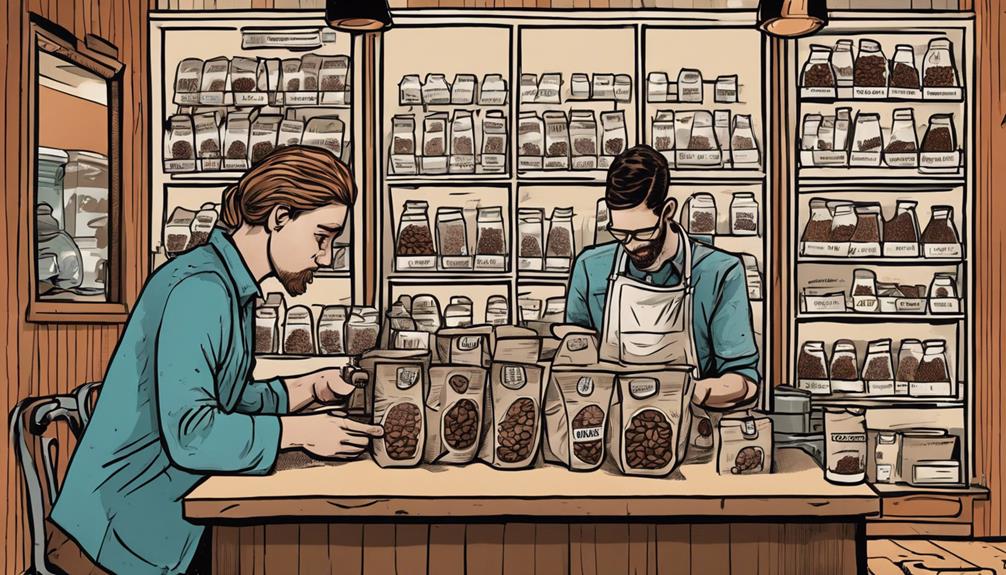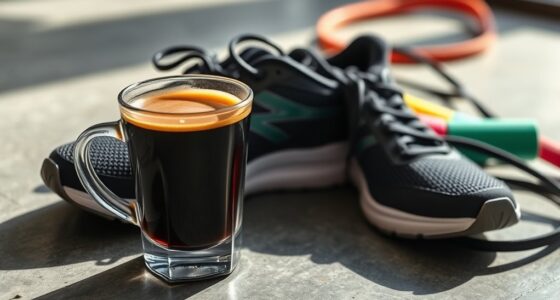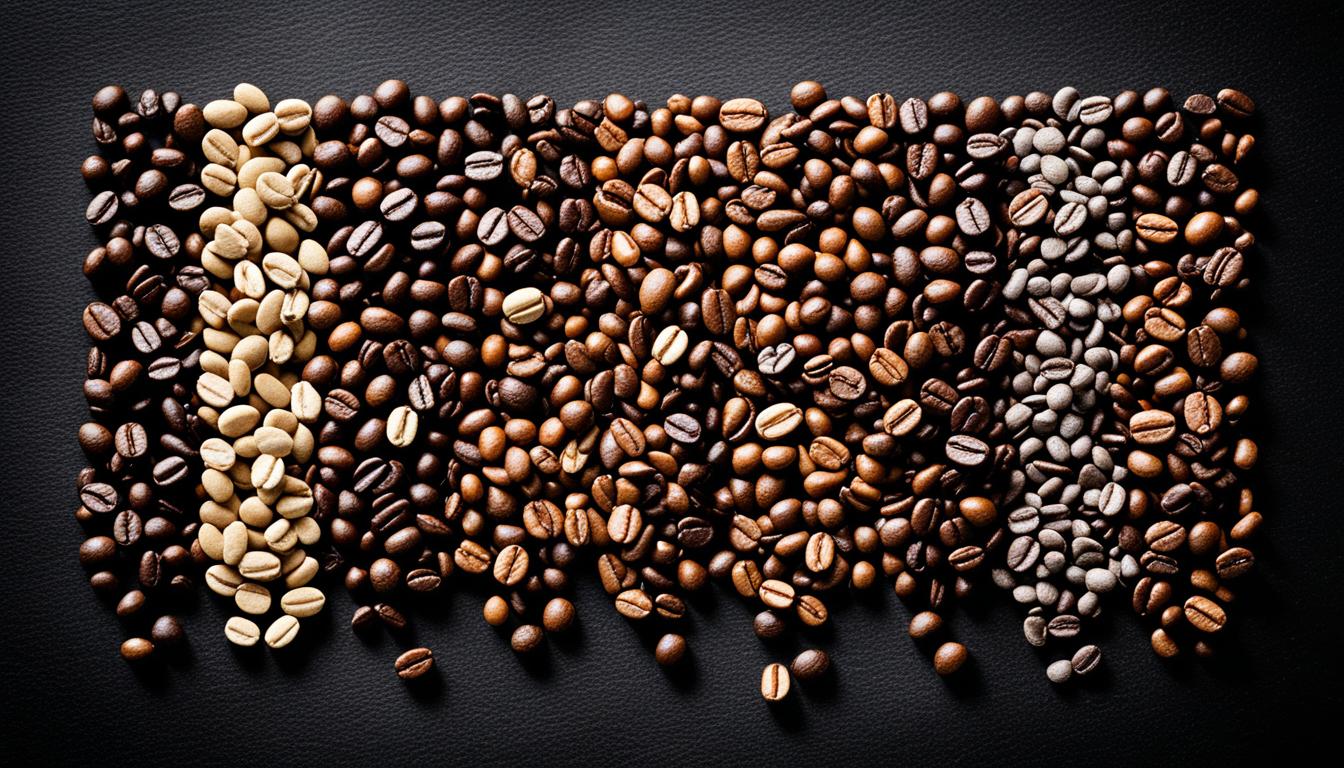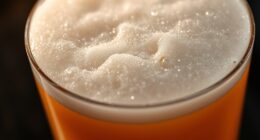To avoid heartburn caused by coffee, consider opting for low-acid Arabica beans or cold brews. Make sure to drink water before enjoying your coffee and have a light snack to help with digestion. Choose dark roasts or decaf for a milder option. Try different brewing methods like AeroPress for a smoother taste. Sit up straight and add a bit of baking soda to balance out the acidity. Include probiotic-rich foods in your diet, stay active, and consult a healthcare provider for comprehensive heartburn management. Tailoring your coffee routine can ensure a stomach-friendly cup.
Key Takeaways
- Choose low-acid Arabica beans for milder acidity.
- Opt for cold brew coffee to reduce acidity levels.
- Stay hydrated before drinking coffee.
- Have a light snack with coffee to aid digestion.
- Avoid heavy meals before or after coffee.
Understanding Heartburn and Coffee
If you experience heartburn, understanding how coffee can worsen this discomfort is important. Coffee is known for its acidity and caffeine content, which can relax the lower esophageal sphincter, allowing stomach acid to flow back up into the esophagus, causing acid reflux and heartburn.
To avoid aggravating heartburn symptoms, it's advisable to opt for low-acid coffee varieties like Arabica or consider cold brew and decaf options. These choices can help minimize the risk of heartburn while still enjoying your cup of coffee.
Additionally, hydrating before consuming coffee, having a light snack, and selecting low-acid coffee blends can further aid in preventing heartburn. By being mindful of the impact of coffee's acidity, caffeine levels, and brewing methods on heartburn, you can better manage and reduce the discomfort associated with coffee consumption.
Choosing Coffee Types for Prevention

When aiming to prevent heartburn from coffee, opt for low-acid Arabica beans and consider cold brew options for a gentler experience. These choices can help reduce acidity levels and lessen the likelihood of triggering heartburn symptoms.
Prioritize hydration and light snacks alongside your coffee to further prevent discomfort.
Low-acid Arabica Recommendations
To reduce the risk of heartburn, opt for low-acid Arabica coffee due to its milder acidity levels. Arabica beans with a pH level of around 5 are a gentler option for those with sensitive stomachs, helping to minimize the chances of triggering heartburn symptoms. Choosing Arabica coffee varieties over Robusta can be beneficial in managing acid reflux and heartburn, providing a smoother coffee experience with reduced acidity.
| Low-acid Arabica Recommendations | Benefits |
|---|---|
| Milder acidity levels | Gentle on sensitive stomachs |
| pH level around 5 | Minimizes heartburn symptoms |
| Reduces chances of heartburn | Smoother coffee experience |
| Ideal for managing acid reflux | Low acidity for comfort |
| Preferred choice over Robusta | Minimizes acid-related issues |
When selecting your coffee, consider opting for low-acid Arabica options to enjoy your cup without the discomfort of heartburn.
Cold Brew Benefits
Cold brew coffee's benefits for preventing heartburn include its lower acidity compared to traditional hot brewed coffee, making it a gentler option for those prone to acid reflux.
The reduced acidity levels in cold brew coffee result from the unique cold brewing process, which produces a smoother and less bitter coffee that's easier on the stomach.
This milder flavor profile is attributed to the prolonged steeping in cold water, creating a stomach-friendly alternative for individuals looking to minimize the risk of triggering heartburn symptoms.
Opting for cold brew coffee can be a strategic choice for those seeking a flavorful yet gentle coffee option. Its reputation for being less acidic makes it a popular choice among individuals aiming to enjoy their coffee without the discomfort of heartburn.
Tips for Selecting Low-Acid Coffee

For a milder coffee with reduced acidity, opt for 100% Arabica beans when selecting low-acid coffee. These beans are known for their smoother flavor profile and lower levels of acidity, making them a great choice for those prone to heartburn. Additionally, consider low-acid coffee blends specifically designed for easier digestion. When choosing the roast level, opt for medium or dark roasts over light roasts to minimize heartburn risk. Dark roasts are generally less acidic due to the longer roasting process.
| Low-Acid Coffee Tips | Benefits |
|---|---|
| Choose Arabica beans | Reduced acidity |
| Opt for dark roasts | Lower heartburn risk |
| Try decaf options | Gentler on the stomach |
Improving Coffee Choices

When it comes to improving your coffee choices, selecting low-acid options can make a significant difference. Consider trying medium or dark roast coffee for a smoother and less acidic flavor profile that may be easier on your stomach.
Additionally, exploring different brewing methods like cold brew can also help reduce acidity levels and potential heartburn triggers.
Low-acid Coffee Options
Choosing 100% Arabica beans can help you enjoy a milder coffee experience with lower acidity levels, reducing the likelihood of heartburn.
When opting for low-acid coffee options, keep these points in mind:
- Look for specially crafted low-acid coffee blends: These blends are designed to be gentler on your stomach and can notably reduce the acidity in coffee.
- Choose medium or dark roasts over light roasts: Light roasts tend to have higher acidity levels, making them more likely to trigger heartburn.
- Consider cold brew coffee: Cold brew is known for its smoother and less acidic profile, which can help minimize the risk of heartburn.
- Hydrate before drinking coffee and pair it with a light snack: Staying hydrated and having a small snack can help lessen the impact of coffee on your stomach, potentially preventing heartburn episodes.
Brewing Method Impact
To improve your coffee choices and minimize the risk of heartburn, consider how different brewing methods impact the acidity levels and flavor profile of your coffee. Experimenting with brewing methods such as AeroPress can result in a smoother coffee flavor and lower acidity levels, which may be gentler on your stomach. Additionally, opting for lower acidity coffee blends or shade-grown coffee varieties can contribute to preventing heartburn. Cold brew coffee options also offer a milder and less acidic alternative to traditional hot brewed coffee, providing a soothing experience for your stomach.
| Brewing Method | Impact on Acidity Levels | Flavor Profile |
|---|---|---|
| AeroPress | Lower acidity levels | Smoother, balanced taste |
| Cold Brew | Reduced acidity | Milder, less bitter |
| Shade-Grown | Potentially lower acidity | Smooth, rich |
Exploring Cold Brew Options

Consider trying out different cold brew options to find an invigorating and stomach-friendly alternative to traditional hot brewed coffee. Here are some key points to keep in mind when exploring cold brew options:
- Less Acidic Taste: Cold brew coffee is known for its smoother and less acidic flavor profile compared to hot brewed coffee.
- Gentler on the Stomach: Opting for cold brew can be gentler on the stomach, making it a suitable choice for individuals prone to heartburn.
- Lower Acidity Level: The slow extraction process of cold brew results in a lower acidity level, reducing the risk of exacerbating heartburn symptoms.
- Low-Acid Options: Choosing low-acid cold brew coffee can be a practical solution for enjoying coffee without triggering heartburn.
Dietary Considerations With Coffee

Pairing your coffee with light snacks instead of heavy meals can help prevent heartburn. Adding soluble fiber to your coffee can also aid in reducing heartburn symptoms.
Before enjoying your cup of coffee, make sure to stay hydrated as this can aid in digestion and lower the risk of heartburn. Opting for low-acid Arabica beans or low-acid coffee blends can help minimize heartburn triggers.
Additionally, be mindful of food pairings that may exacerbate heartburn when enjoying your coffee. By making these dietary considerations such as opting for light snacks, adding soluble fiber, staying hydrated, choosing low-acid beans, and watching your food pairings, you can enjoy your coffee without the discomfort of heartburn.
Posture and Brewing Techniques

Adjusting your posture and exploring different brewing techniques can play a significant role in managing heartburn triggered by coffee consumption.
Here are some tips to help you combat acid reflux and reduce the risk of heartburn symptoms:
- Maintain Proper Posture: Sitting upright after drinking coffee can aid in preventing the backward flow of stomach acids into the esophagus, minimizing the chances of heartburn.
- Experiment with Brewing Methods: Trying out brewing methods like AeroPress or cold brew can result in a smoother coffee flavor with potentially lower acidity levels, which may be gentler on your stomach.
- Tailor Your Coffee Experience: By exploring different brewing techniques, you can customize your coffee to suit your preferences and minimize the acidity that could trigger heartburn.
- Stay Mindful of Acidic Coffee: Be aware of the acidity levels in the coffee you consume and consider opting for less acidic varieties to help manage heartburn symptoms effectively.
General Health Tips for Heartburn

Incorporate probiotic-rich foods like Greek yogurt into your diet to improve digestion and potentially find relief from heartburn symptoms.
Maintaining a healthy weight and engaging in regular exercise not only supports overall digestive health but also reduces the risk of experiencing heartburn.
Prioritize consulting a healthcare provider before reintroducing coffee into your diet to effectively manage heartburn symptoms. It is important for individuals with heartburn symptoms to consult a healthcare provider before making any changes to their diet, including reintroducing coffee. Certain compounds in coffee, such as caffeine and acids, can aggravate heartburn and worsen symptoms. Coffee enemas and sibo connection should also be considered when discussing potential triggers for heartburn with your healthcare provider, as these factors can play a role in managing symptoms effectively. It is essential to work with a healthcare professional to determine the best course of action for managing heartburn and making any dietary adjustments.
Avoid consuming heavy meals and coffee close to bedtime as this can trigger heartburn.
Additionally, incorporating soluble fiber to your diet, such as oatmeal or chia seeds, can aid digestion and potentially alleviate heartburn discomfort.
By making these lifestyle adjustments, you can take proactive steps towards preventing heartburn and promoting better digestive health.
Frequently Asked Questions
How Do I Keep Coffee From Giving Me Heartburn?
To keep coffee from giving you heartburn, opt for low-acid Arabica coffee or try cold brew/decaf options. Stay hydrated, snack lightly, and add soluble fiber to your coffee. Avoid pairing coffee with heartburn-triggering foods and heavy meals before bed.
How Do You Make Coffee Less Acidic for Heartburn?
To make coffee less acidic for heartburn, opt for low-acid Arabica beans, try cold brew, add milk, or choose a less acidic blend. Experiment with brewing methods like AeroPress or French press. Find what works best for your stomach.
What Can I Drink Instead of Coffee to Avoid Acid Reflux?
To avoid acid reflux, opt for soothing herbal teas like chamomile or ginger, non-citrus juices such as apple or pear, low-fat or plant-based milk, hydrating coconut water, and gentle almond or oat milk lattes instead of coffee.
Will Quitting Coffee Help Heartburn?
Quitting coffee can reduce heartburn noticeably for many. Experiment with low-acid or decaf options to find what works for you. Consult a healthcare provider for personalized advice on managing heartburn and adjusting coffee intake.
Conclusion
So, next time you reach for your morning cup of joe, remember to opt for a low-acid coffee to avoid heartburn.
Did you know that approximately 20% of coffee drinkers experience heartburn symptoms?
By making simple changes to your coffee choices and brewing techniques, you can enjoy your favorite beverage without the discomfort of heartburn.
Cheers to a heartburn-free coffee experience!









